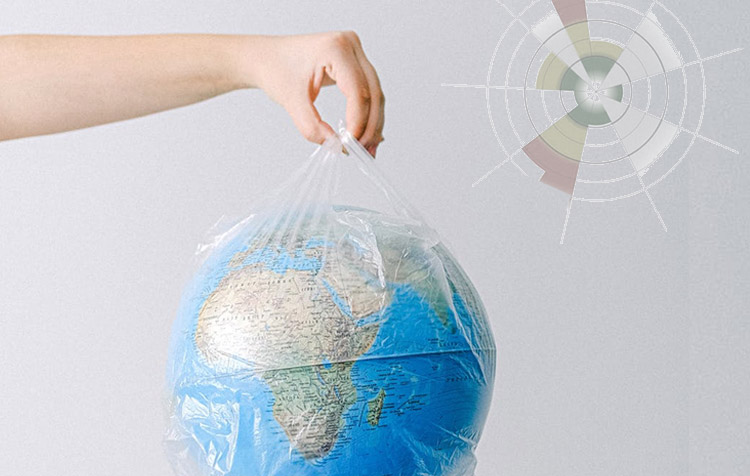What are planetary boundaries, anyway? You've probably heard this term in the news, on political talk shows, or at one of the many climate rallies. It describes the limits of the Earth's resilience, which is determined by nine different global processes.
We humans are through the massive consumption natural resources und eine gesamtgesellschaftlich umweltschädliche Lebensweise wesentlich dafür verantwortlich, dass unser Planet mehr denn je in Gefahr ist. Auch deshalb sind wir gezwungen, schleunigst Lösungen für die biggest environmental problems of our time find
In diesem Artikel möchte ich dir jetzt alles Wissenswerte über das Konzept der planetaren Grenzen erläutern und zeigen, welche Prozesse dabei eine wesentliche Rolle spielen. Auf geht's!
You can find a brief overview of the article here in advance:
Die Definition – Was sind planetare Grenzen?
Das Konzept der Planetaren Grenzen (engl. Planetary Boundaries) dient dazu, anhand von neun zentralen, natürlichen Systemen und Prozessen, Aussagen über die Erdgesundheit und die Lebensgrundlagen der Menschheit treffen zu können. Es wurde im Jahr 2009 von etwa 30 internationalen Wissenschaftlerinnen und Wissenschaftlern um Johan Rockström vom Stockholm Resilience Centre in einem Fachartikel publiziert.₁
The global processes and their current state, of which the ökologische Tragfähigkeit des Planeten wesentlich abhängig ist, wurde auf Basis naturwissenschaftlicher Erkenntnisse und unter Anwendung des Vorsorgeprinzips ermittelt.
Wo liegt der Unterschied zu den Klima Kipppunkten und dem Erdüberlastungstag? Während die Planetaren Grenzen ein Abhängigkeitskonzept zur Bewertung der Erdgesundheit darstellen, sind die Climate tipping points wichtige Elemente der Erdsystemforschung, die ab einem bestimmten Punkt beschleunigende Wirkung auf die Erderwärmung haben.
The "Earth Overshoot Day. describes the day in a year when humanity has consumed more renewable resources than the planet can reproduce in the entire year.
What are the planetary boundaries and determining global processes?
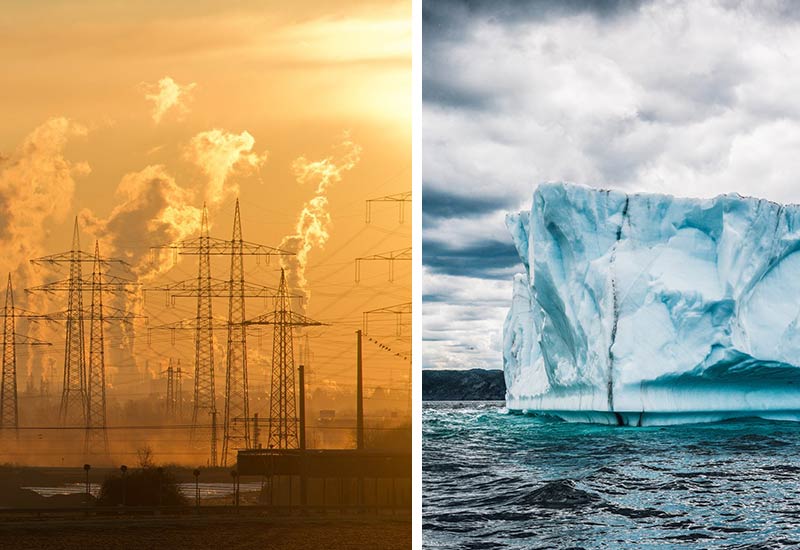
Nun weißt du, dass das wissenschaftliche Konzept der Planetaren Grenzen zeigt, how well or badly our earth is doing. Um welche erdsystematischen Prozesse es sich dabei ganz genau dreht, möchte ich dir nun erläutern.
Notice: In each case, I also introduce you to the main causes of the problem and the things each of us can do about it in our everyday lives.
1. climate change
Der Anstieg des Meeresspiegels, langandauernde Dürreperioden oder Extreme weather and natural disasters are increasing consequences of climate change. The anthropogenic Greenhouse effect and Tipping Points, wie der Kollaps des Amazonas-Regenwaldes oder die Zerstörung der Korallenriffe, beschleunigen das Umweltproblem der global warming.
- Causes: Among other things, the Deforestation of the rainforests, das menschliche Konsumverhalten, der hohe Energieverbrauch von Gebäuden und unzählige Flugreisen als wesentliche Gründe für die rasanten Klimaveränderungen.
- Lösungsvorschläge: Die entscheidende Maßnahme ist es, bewusst to live more climate friendly. Beispielsweise indem man Autofahrten und Flugreisen möglichst durch die Nutzung öffentlicher Verkehrsmittel ersetzt.
2. New substances and modified life formen
Toxic substances such as Pesticides, heavy metals, radioactive materials or Nanoparticles können in der Natur nur schwer abgebaut werden. Auch deshalb kann ihre Einbringung in die Umwelt schwere Folgen für Mensch, Tier und die Erde haben.
Beispielsweise können sich neue gentechnisch modifizierte Lebensformen bilden, die in der Lage sind, Ökosysteme aus ihrem natürlichen Gleichgewicht to bring.
- Causes: Eine Gefahr für die Erdgesundheit besteht beispielsweise durch Mülldeponien, Endlager für radioaktive Abfälle oder durch den Einsatz von chemischen Düngern und Pflanzenschutzmitteln.
- Lösungsvorschläge: Vermeide Müll im Alltag so gut es geht, steige auf Ökostrom um und prefer organic food aus der ökologischen Landwirtschaft.
3. Intaktheit der Biosphäre
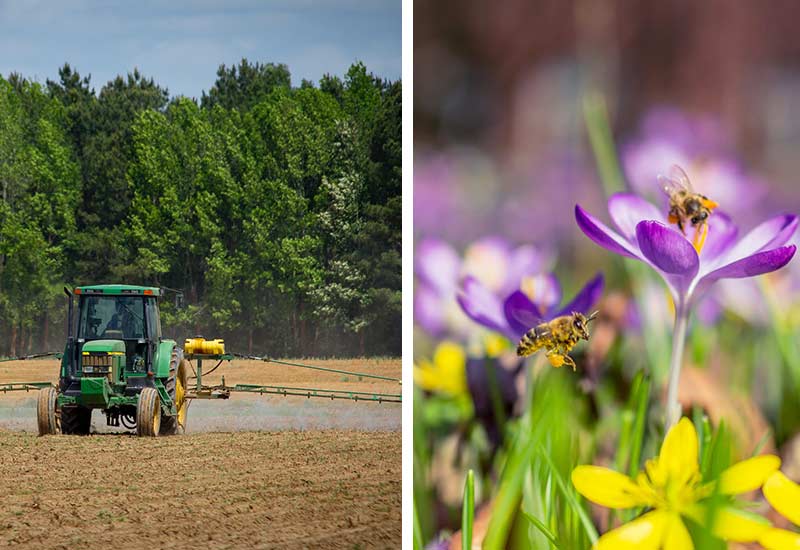
Die Unversehrtheit der Biosphäre ist ebenfalls ein entscheidender Prozess der Planetaren Grenzen. Innerhalb von Lebensräumen, sind unzählige Tier- und Pflanzenarten voneinander abhängig. Sterben beispielsweise pflanzenbestäubende Insekten like the bee, many plant species and foods will no longer exist.
- Causes: Ein wesentlicher Grund für das Insektensterben ist der Einsatz chemischer Pflanzenschutzmittel in der Landwirtschaft.
- Lösungsvorschläge: Eine sinnvolle Maßnahme ist es, durch die Änderung der eigenen Lebensweise dazu beizutragen, dass das Species extinction is stopped. Among other things, this works by giving preference to foods from the organic farming.
Tip: What else you can do in everyday life do against insect mortality kannst, erläutere ich dir gern im ausführlichen, verlinkten Blogbeitrag.
4. Ozonverlust der Stratosphäre
In der Stratosphäre befindet sich Ozone, dass Teile der UV-Strahlen aus dem Sonnenlicht abblockt. Doch manche Gase aus der Industrie können die Ozonschicht beschädigen, sodass ungewöhnlich große Mengen der Ultraviolettstrahlung zur Erde gelangen.
- Causes: Fluorchlorkohlenwasserstoffe aber auch polare Stratosphärenwolken tragen zur Verringerung der Schutzwirkung des Ozons bei.
- Lösungsvorschläge: Der Ausstoß ozonzerstörender Substanzen muss verboten werden, um diesen globalen Prozess im sicheren Handlungsraum zu bewahren.
5. Aerosolgehalt der Atmosphäre
The aerosols, tiny particles in the air such as. Fine dust, beeinflussen das Klimasystem, das Wetter und auch unsere Gesundheit. Eine veränderte Wolkenbildung oder Atemwegserkrankungen sind übliche Folgen.
- Causes: The air pollution der Atmosphäre ist vor allem eine Folge der Abgase von Fabriken, Flugzeugen, Schiffen oder Autos.
- Lösungsvorschläge: You too can use the Minimize air pollution. Zum Beispiel, indem du weniger Müll produzierst, weniger unnütze Dinge konsumierst und öfter Bahn fährst, anstatt mit dem Flugzeug zu fliegen.
6. Land Use Change
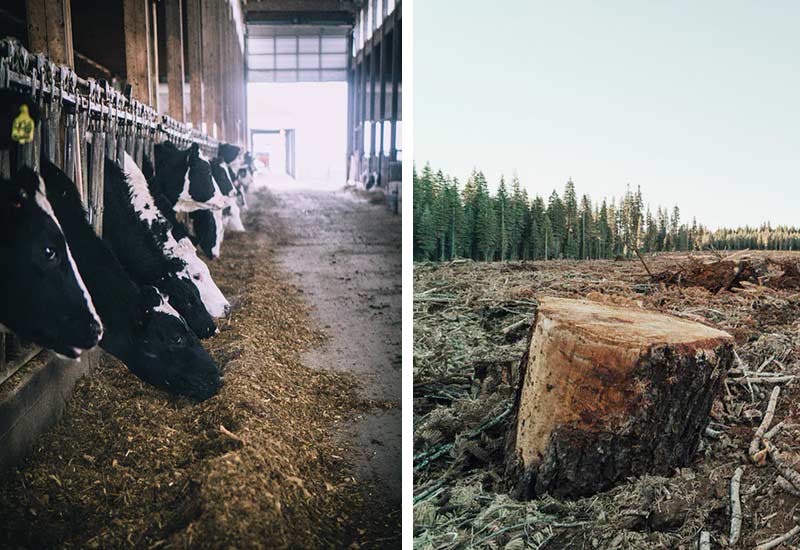
Der Wald ist in der Lage, die Erde zu kühlen und durch den Menschen ausgestoßenes CO2 zu binden. Der enorme Flächenverbrauch für Fleisch and others, animal food führt jedoch dazu, dass Wälder weichen müssen.
The safe Handlungsraum dieses Prozesses wurde bereits deutlich überschritten, sodass ein erhöhtes Risiko für gravierende Folgen besteht.
- Causes: Die bedrohliche Landnutzungsveränderung ist eine wesentliche Folge des Tierfutteranbaus und der Schaffung von Weideflächen für die Factory farming.
- Lösungsvorschläge: The vegan lifestyle ohne Tierausbeutung – und stattdessen mit dem direkten Verzehr der angebauten Pflanzen – trägt wesentlich zur Lösung dieser Problematik bei.
7. Biogeochemische Kreisläufe
Seeing another Planetary Boundaries process Johan Rockström und sein Team in der Veränderung biogeochemischer Kreisläufe. Stickstoff und Phosphor befinden sich ganz natürlich im Boden. Durch die Einbringung von chemischen Düngemitteln however, the existing quantities are increasing exorbitantly.
Überschüsse werden vom Regen in umliegende Seen gespült (Eutrophierung), in denen in der Folge das Algenwachstum bedrohlich zunimmt und ganze Ökosysteme bedroht.
- Causes: Vor allem durch die Überdüngung in der Landwirtschaft (z.B mit Slurry) kommt es zur Anreicherung von Nährstoffen in ursprünglich nährstoffarmen Ökosystemen.
- Lösungsvorschläge: Die Bevorzugung von pflanzlichen Bio-Produkten aus ökologischer Landwirtschaft ist ein wertvoller Lösungsansatz.
8. acidification of the oceans
Among them is the Decrease in the pH value of the seawater zu verstehen. Calcit und Aragonit reagieren im Meerwasser mit dem im Meer gebundenen Kohlenstoffdioxid. Die entstehende Kohlensäure greift in der Folge beispielsweise Muscheln an und kann das Coral mortality Accelerate.
- Causes: Sobald der CO2-Druck in der Atmosphäre höher als der des Ocean ist, wird Kohlendioxid im Oberflächenwasser des Ocean gelöst. Die menschlichen Treibhausgasemissionen tragen wesentlich dazu bei.₂
- Lösungsvorschläge: Du kannst unterstützen, indem du deinen persönlichen, ökologischen Fußabdruck reduzierst and live in a more climate-friendly way.
Tip: What you specifically can do against coral mortalityI have collected together in a separate article on the blog. If you like, feel free to take a look!
9. Süßwassernutzung
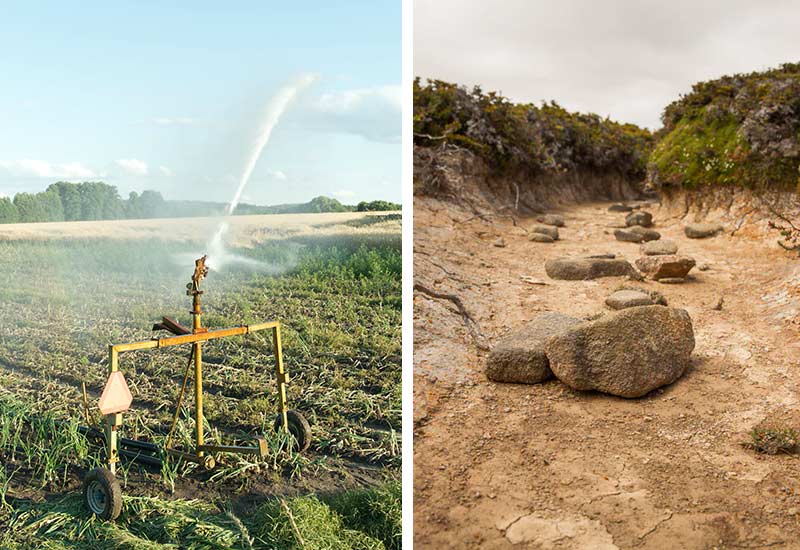
Wasser wird nicht nur direkt im Haushalt, sondern auch indirekt, zum Beispiel für Lebensmittel und Kleidung, verbraucht. Dieser sogenannte Virtual water consumption entsteht beispielsweise durch die Bewässerung von Tomaten- oder Baumwollfeldern und bedroht die begrenzten Süßwasserbestände in Teichen, Flüssen und Seen.
- Causes: Ein simples Beispiel hilft, die Problematik zu verdeutlichen. Um ein Kilogramm Fleisch zu erzeugen, sind mehr als 15.000 Liter Wasser (z.B. für Tierfutteranbau, Stallreinigungen etc.) notwendig.₃ Auch wenn man ihn als Konsument nicht sieht, spielt dieser indirekte Wasserverbrauch eine wichtige Rolle für die Belastungsgrenzen der Erde.
- Lösungsvorschläge: Verfolge eine möglichst pflanzliche Ernährungsweise und Consciously save water in the household.
What is the state of the Planetary Boundaries?

Here above in the graphic you can already see the respective Zustände und Bedrohungen of the global processes of planetary boundaries just described.
Prozesse, die hier ausschließlich im grünen Bereich (von Rockström und Kollegen empfohlener Bereich) dargestellt sind, gelten (noch) als sicher bzw. gesund. Das ist momentan bei der Süßwassernutzung, der Versauerung der Meere und dem Ozonverlust der Stratosphäre der Fall.
Der Klimawandel, sowie die Landnutzungsveränderungen befinden sich zur Zeit bereits in the yellow range, der Prozesse beschreibt, die ein erhöhtes Risiko darstellen und deren Folgen für die Umwelt schwer einzuschätzen sind.
Die biogeochemischen Kreisläufe, sowie die Genetische Vielfalt (als Teil des Prozesses der Intaktheit der Biosphäre) befinden sich in the red range, der den globalen Prozessen gilt, die sich im Bezug auf die Belastungsgrenzen der Erde in der Hochrisikozone befinden. Das heißt, es sterben derzeit bedrohlich viele Tier- und Pflanzenarten aus – auch als Folge der Einbringung von chemischen Düngemitteln.
Nicht außer Acht lassen sollten wir den gray area, der die Prozesse beschreibt, deren Belastungsgrenze noch gar nicht bekannt und definiert sind. Das ist beim Aerosolgehalt der Atmosphäre, der Einbringung neuer Substanzen und modifizerten Lebensformen, sowie der funktionalen Vielfalt (auch als Teil der Intaktheit der Biosphäre) der Fall.
Know planetary boundaries and act!
Unsere derzeitige Lebensweise beutet die Ressourcen des Planeten aus und zerstört natürliche Ökosysteme. Doch die Earth is not infinitely resilient.
The Planetary Boundaries concept combines the Interactions of the global processes and gives Aufschluss über den Gesundheitszustand unserer Erde – und uns Menschen einen Rahmen, um unsere Umwelt intakt zu halten.
Zudem liefert sie wertvolle Erkenntnisse, die zur Anpassung unseres persönlichen Verhaltens motivieren, damit wir selbst zum Teil der Problemlösung werden can.
"The greatest threat to our planet is the belief that someone else will save it."
Robert Swan (more at Environmental protection quotes)
Do you have any questions, suggestions or further valuable information about Planetary Boundaries? Then I look forward to your comment.
Stay sustainable and environmentally conscious,

PS: In my Knowledge blog I present you many more Technical terms from the fields of environmental protection and sustainability in front of you. Learn now, for example, what is meant by the word Littering versteht. Viel Spaß!
References:
₁ BMUV (2021): Planetare Belastbarkeitsgrenzen, abrufbar unter https://www.bmuv.de/themen/nachhaltigkeit-digitalisierung/nachhaltigkeit/integriertes-umweltprogramm-2030/planetare-belastbarkeitsgrenzen. [22.09.2023].
₂ Climate Service Center: Ozeanversauerung, abrufbar unter https://wiki.bildungsserver.de/klimawandel/index.php/Ozeanversauerung. [22.09.2023].
₃ Umweltbundesamt (2017): Verstecktes Wasser (Stand: 22.03.2017), abrufbar unter https://t1p.de/ddfg. [22.09.2023].

